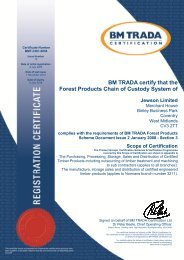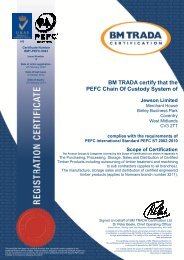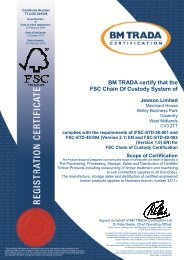How-to Guide tooLS you wiLL need MAteRiALS you wiLL ... - Jewson
How-to Guide tooLS you wiLL need MAteRiALS you wiLL ... - Jewson
How-to Guide tooLS you wiLL need MAteRiALS you wiLL ... - Jewson
You also want an ePaper? Increase the reach of your titles
YUMPU automatically turns print PDFs into web optimized ePapers that Google loves.
PREPARATION<br />
• First, decide what <strong>you</strong> want <strong>to</strong> use the loft for<br />
as this will determine what kind of insulation<br />
<strong>you</strong> will <strong>need</strong>.<br />
• The simplest way of insulating is by rolling out a<br />
double layer of insulation blanket between the<br />
joists then cross-wise over them.<br />
• If <strong>you</strong> plan <strong>to</strong> use the loft for s<strong>to</strong>rage, then <strong>you</strong><br />
will <strong>need</strong> strong boarding, making sure each<br />
piece is big enough <strong>to</strong> cover at least three joists<br />
for stability<br />
• Next, measure <strong>you</strong>r loft. Check the space<br />
between joists and buy insulation at the<br />
appropriate width and length.<br />
• Make sure <strong>you</strong>’re fully protected with overalls,<br />
mask and gloves. Insulation can be irritating <strong>to</strong><br />
the skin and its fibres must not be inhaled.<br />
• Check that <strong>you</strong>r work area is properly lit<br />
• Ensure all other work <strong>to</strong> the loft is complete and<br />
safe (such as plumbing and wiring).<br />
• If <strong>you</strong>r loft isn’t fully boarded, make sure <strong>you</strong><br />
tread carefully, as the spaces between the joists<br />
won’t hold <strong>you</strong>r weight. This will avoid damage<br />
<strong>to</strong> the ceiling below and injury <strong>to</strong> <strong>you</strong>.<br />
DOING THE JOB<br />
ALTERNATIVE MATERIALS<br />
• First, check that <strong>you</strong> won’t be covering any<br />
electrical wires, as this can cause overheating.<br />
• Fasten any wires <strong>to</strong> the sides of joists with the<br />
cable clips.<br />
• If there are any downlights inset in<strong>to</strong> the ceiling<br />
of the room below, make sure <strong>you</strong> fit downlight<br />
heat diffusers <strong>to</strong> these before laying the insulation<br />
– again <strong>to</strong> avoid overheating.<br />
• Next, unroll the insulation blanket from the eaves<br />
<strong>to</strong> the centre making sure it completely fills the<br />
space between the joists. Leave a gap at the very<br />
edge of the eaves <strong>to</strong> ensure natural ventilation<br />
and eliminate condensation.<br />
• Roll out <strong>to</strong> the centre, then cut and repeat from<br />
the other end, making sure the ends butt snugly<br />
against each other.<br />
• Once this layer is complete, repeat at 90°<br />
from the previous layer, going perpendicular<br />
<strong>to</strong> the direction of the joists. Do not compress<br />
either layer, as this will compromise its thermal<br />
performance<br />
If the spaces between <strong>you</strong>r joists are not uniform,<br />
then a roll of insulation blanket may not be<br />
appropriate. In these cases, it may preferable <strong>to</strong><br />
empty sacks of loose-lay material in<strong>to</strong> the spaces<br />
between joists.<br />
Before doing this, make sure none of the<br />
material can disappear down the cavity wall<br />
by blocking the eaves with lengths of timber<br />
between the joists. As above, be careful not<br />
<strong>to</strong> block this area completely, so as <strong>to</strong> avoid<br />
condensation. Also, seal any holes in the ceiling,<br />
such as those through which pipes or wiring are<br />
fed, with expanding foam filler.<br />
Next, empty sacks of loose-lay in<strong>to</strong> the spaces.<br />
Use the edge of a piece of wood <strong>to</strong> smooth and<br />
level off the layer. Once this is laid, be aware<br />
that every time <strong>you</strong> open or close the loft the<br />
draught can blow the material about, so a layer<br />
of blanket insulation or board insulation over the<br />
<strong>to</strong>p is advisable.<br />
LAYER 1<br />
JOISTS<br />
LAYER 1<br />
JOISTS<br />
LAYER 2<br />
LAYER 1<br />
JOISTS<br />
LAYER 1<br />
JOISTS<br />
LAYER 1<br />
• Insulate over the cold-water tank, but not under it.<br />
If it’s <strong>to</strong>o well insulated from heat below it<br />
may freeze (see other essentials below for<br />
more information)













